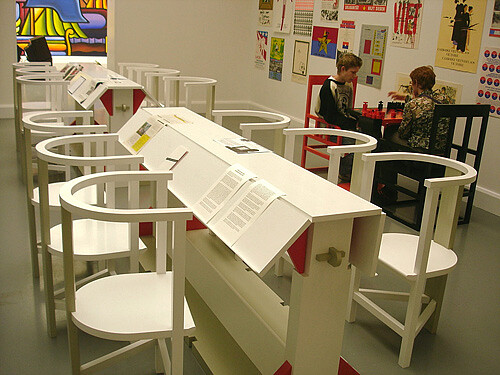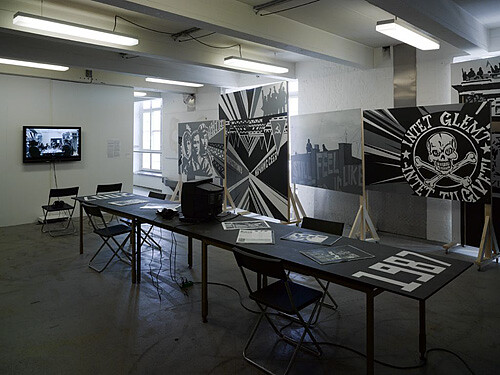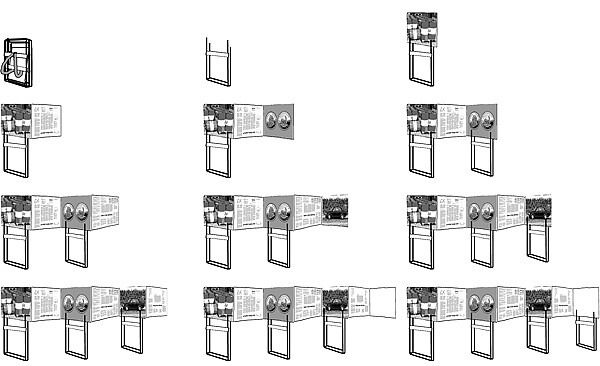→ Continued from “Art and Thingness, Part One: Breton’s Ball, Duchamp’s Carrot” in issue 13.
In a text written in response to the upheavals of the Russian Revolution and the early Soviet avant-garde, Carl Einstein claimed that tradition “piles up in the object”; that the object is a “medium for passive thinking,” bound to tradition and bourgeois property relations; and that in order to “assert the human person, objects, which are preserve jars, must be destroyed.” Going so far as to state that “every destruction of objects is justified,” Einstein proclaimed a “dictatorship of the thingless.”1 Einstein’s text seems to reflect simplistic narratives in which modernity is virtually synonymous with a purist, idealist suppression of the thing. Of course, such idealist tendencies did exist, but so did opposition to them. As if responding to Einstein’s quasi-Suprematist essay, Adorno once remarked that “someone who looks upon thingness as radical evil, who wants to dynamize all that exists into pure actuality, tends to be hostile to otherness, to the alien—which has lent its name to alienation, and not for nothing.”2
In a Latourian manner, one might present the recent turn to the thing as a break with the project of modernity: after all, isn’t modernity in theory and in praxis the desperate attempt to (re)form the world in accordance with the will of an autonomous, imperious subject that turns things into ordered and emaciated objects? Such an opposition, however, is dubious; as Adorno’s remark may serve to recall, it is not only manifestly “anti-modern” modern philosophers, such as Heidegger, who prefigure the recent thing-turn. Adorno too was far from embracing objects or things as they were, rooted as his thought was in the Marxian analysis of commodity fetishism and the Lukácsian critique of reification or Verdinglichung. After all, isn’t the very term Verdinglichung—literally “thingification,” to which an important section of Lukács’ History and Class Consciousness is dedicated—manifestly idealist?
For all the problems with History and Class Consciousness—of which Lukács was well aware later in his life—it remains worthwhile to trace the main steps of its argument, whose repercussions can scarcely be overestimated. Lukács’ starting point is Marx’s analysis of commodity fetishism, in which “a definite social relation between men” assumes “the fantastic form of a relation between things,” which Lukács characterizes as “the basic phenomenon of reification.”3 But the fetishist illusion of commodities—as “social things” whose exchange value appears to follow gratuitous whims—is only one half of reification; it is not only that the commodities form a spectacle of quasi-subjects, but the subjects themselves, as workers, are transformed. In consequence of the rationalization of the work process the human qualities and idiosyncrasies of the worker appear increasingly as mere sources of error when contrasted with these abstract special laws functioning according to rational predictions. Neither objectively nor in his relation to his work does man appear as the authentic master of the process; on the contrary, he is a mechanical part incorporated into a mechanical system. He finds it already preexisting and self-sufficient; it functions independently of him and he has to conform to its laws whether he likes it or not. As labor is progressively rationalized and mechanized, his lack of will is reinforced by the way in which his activity becomes less and less active and more and more contemplative.4
According to Lukács, modern philosophy reflects reified consciousness. Starting with Kant, philosophy had set itself “the following problem: it refuses to accept the world as something that has arisen (or has been created by God) independently of the knowing subject, and prefers to conceive of it instead as its own product.”5 However, absolute idealism with its exclusive focus on the absolute “I” proved untenable, as idealist philosophy had to take its departure precisely from the split between subject and object, which it sought to overcome, to sublate—to contain within a higher unity from which the philosophers “could ‘create,’ deduce and make comprehensible the duality of subject and object on the empirical plane, i.e. in its objective form.”6 The world was now conceived in terms of a dialectical process that shattered the original, absolute unity, but restored it on a higher level. It is precisely where idealist philosophy finds its limit in the dialectical process—which it conceives in abstract terms as being enacted by subject and object—that Lukács begins to reflect upon an economy in which the subject is alienated from its objective conditions, and in which the products of labor take on quasi-subjective qualities.
Marx broke with the philosophical deadlock of idealism by using the dialectical method to analyze dialectical processes between classes. Lukács himself, however, gave a rather idealist interpretation to this materialist turn; as he later admitted, his explicit presentation of the proletariat as the identical subject-object of history was still highly idealist.7 In his autocritique, he also argued that he had unduly equated reification with alienation, and furthermore that he had tended to identify alienation with objectification; in fact, objectification is unavoidable, as any type of society must to some extent objectify itself in practice, in physical objects as well as in social structures. Alienation, on the other hand, based on commodity fetishism or reification, is not a given; structures that alienate man from his own nature must be abolished.8
If at first sight Carl Einstein’s text appears to merely celebrate an idealist triumph of pure spirit—of the abstracted subject—over objects, on closer inspection it becomes clear that Einstein too wishes to go beyond the dichotomy of subject and object. Stating that “the object no longer dominates vision; rather vision is now directed against the object, ruthlessly, dictatorially,” Einstein proclaims a project of revolutionary Entdinglichung (a reversal of Verdinglichung), resulting in a “dictatorship of vision, ascetics of the object, destruction of facts, and accordingly, renunciation of the self.” It is not so much a matter of the subject triumphing over the object, but of a new vision that creates a new “fluctuant experience of space.”9 In admittedly idealist terms (that also recall some of Raoul Hausmann’s writings from the period), Einstein here sketches a situation in which a form of praxis generates experiences that undermine any stable dichotomy of subject and object.


In this sense, he comes close to the Constructivist/Productivist theorists of the veshch, the object that would offer an alternative to the “idolized” commodity-object of Western capitalism. Writing from Paris in 1925, Aleksandr Rodchenko wrote that “the light from the East is in the new relation to the person, to woman, to things. Our things in our hands must be equals, comrades, and not these black and mournful slaves, as they are here.”10 Later, Brecht would paraphrase Hegel by stating that “things are occurrences” rather than immovable states.11 We are dealing here with a constellation of Marxian attempts at redefining the role of objecthood and thingness—a constellation that also includes Adorno, in whose development History and Class Consciousness played a crucial role. Adorno’s most developed thoughts on the matter are to be found in Negative Dialectics, where he places great emphasis on the dangers of equating objects with alienation. “In Marx one can already find the difference between the object’s primacy as something to be produced critically and its caricature in things as they are (im Bestehenden), its distortion by the commodity character.”12
Dialectics becomes materialist when the primacy of the object is established; yet, Adorno warns, “the primacy of the object notwithstanding, the thingness of the world is also illusory. It tempts the subjects to ascribe to the things themselves the social conditions of their production. This is elaborated in Marx’s chapter on the fetish …”13 What is crucial for Adorno is to combine “tenacious opposition against that which exists: against its thingness,” with a staunch rejection of attempts to identify thingness as evil.14 “In thingness there is an intermingling of both the object’s unidentical side and the subjection of people under the prevailing forms of production—their own functional relations, which are obscure to them.”15 While, on the one hand, thingness (das Dinghafte) stands for the subjection of people under alienating and mystifying forms of production; on the other, the thing stands for the non-identical, for that which escapes the clutch of instrumental reason. It does so more fully than the object, which is “the positive face of the non-identical”; in other words, “a terminological mask.”16 Objecthood is thingness objectified, subjected to concepts in the same way that a subject is a person become concept, a legal-philosophical abstraction; a thing is to an object as a person is to a subject.


Aleksandr Rodchenko, Workers’ Club, in “Forms of Resistance” at the Van Abbemuseum in Eindhoven, 2007.
However unlikely this may sound to those who think of Adorno only as a late-modernist mandarin, his thinking in this respect echoes of debates that raged in the 1920s and 1930s and can be seen as a belated contribution to the theory of Productivism, of an art aiming to construct new types of things that would be true “comrades.” The crucial term veshch can be translated either as “thing” or as “object” (as in the case of Lissitzky and Ehrenburg’s journal Veshch/Gegenstand/Objet), but a dominant motif in Productivist theory was the need to go beyond fetishized capitalist object-commodities towards a new type of veshch production and distribution that would no longer hide the things’ histories, the productive conditions that shaped them. The counterpart of the new veshch-thing is of course a notion of self different from the classical-modern subject; noting critically that Paris was marked by a “cult of woman as thing,” Rodchenko attempted to redefine both thing and person in their interrelationships.17
It is above all this aspect of Constructivism/Productivism that relates to present concerns—as it was to those of the late 1960s and early 1970s, the period that saw the rediscovery of Constructivism in a different sense than its formalist reduction by the likes of Naum Gabo and George Rickey.18 The recent purchase of a reconstruction of Rodchenko’s 1925 Workers’ Club by the Van Abbemuseum in Eindhoven—which already around 1970 played an important role in the rediscovery of the social and political side of Constructivism—is a significant event, provided that the museum avoids presenting Rodchenko’s furniture (which rejects the semiotic reduction of chromed “functionalism” in favor of flexible constructions that demand an active user) as a nostalgic and reified image of the early Soviet Union. For all the doubts we may harbor about aspects of the Constructivist project, such as its belief in relentless industrialization, Rodchenko’s attempt to redefine and reform things and their role in human life—of which the Workers’ Club forms one partial realization—can overlap with the present in a momentary Jetztzeit.


Chto Delat/What is there to be done?, “Representing Perestroyka,” 2008, U-Turn Biennial, Copenhagen Denmark.
Now that everyday life is increasingly marked by convoluted attempts to gain some insight into the tangled thingness in which we are embedded, to trace the origins of the food we buy, to try and quantify the production of pollution resulting from our energy consumption, to do more than merely survive under ever more precarious working conditions, Productivism chimes with current concerns. It is reactivated in current practices such as that of Chto Delat, even if the formal means employed in their videos and installations sometimes court the risk of appearing to be exercises in nostalgic retro chic.19 In a less literal way, a similar impulse can be detected in the activities of Temporary Services, for example in the recent “Art Work,” an exhibition in the shape of a newspaper discussing the consequences of the collapse of the economy for artists, and pushing for “new ways of doing things, developing better models.”20 Here one may also think of Natascha Sadr Haghighian’s Solo Show project (2008), which foregrounded the semi-hidden world of companies that produce work for today’s big artists by giving a man used to interpreting artists’ designs a much more active role in determining the show’s content, as well as that of her earlier installation, …deeply__to the notion that the__world is__to the observer…(committed) (real) (external).21
…deeply__to the notion that the__world is__to the observer…(committed) (real) (external) contains a video in which two women set up a do-it-yourself billboard in the middle of a highway. The billboard itself, which shares the space with the video projection, consists of a series of photo/text montages that address, in a less than linear way, the consequences of multiple events of the early 1970s: the collapse of the gold standard, the rise of conceptual art and immaterial labor, and the transformation of the dollar into a “virtual currency” whose fate is, however, linked to the price of oil. All of its graphic components can be downloaded from the Internet and then printed and pasted onto a self-assembled wooden structure. Rather than a didactic exposition molding these elements into a clear-cut narrative, the board’s montage creates juxtapositions that are, quite literally, questionable. How exactly does the rejection of the object in conceptual art relate to the collapse of the gold standard, and immaterial labor to the continuing importance of oil—the oneiric master-commodity? Having been emphatically told that various wars were definitely not about oil, should we believe such statements any more than the rhetoric of dematerialization employed in the context of conceptual art? In spite of the increasing importance of certificates for determining the rights to a work of art, in the world charted by Haghighian’s Solo Show, the concepts faxed or mailed by managerial artists are still destined for production by specialized companies—a division of labor that Haghighian’s project undermines by instigating a different working relationship, one that leads to the production of mutant things.


Graphic illustrating the construction of the billboard from …deeply__to the notion that the__world is__to the observer…(committed) (real) (external).
Clearly, today a search for “new ways of doing things, developing better models” does not imply the abstract negation of the past propagated by Carl Einstein or, in a different manner, by the Productivists. Yesterday’s tabula rasa is now itself part of the historical repertory—at times neutralized through nostalgic quotations, at other times activated in the form(s) of projects that treat the historical material as a potential waiting to be actualized, however partially and fleetingly.22 But if Neo-Productivist impulses can be found in a number of important practices and projects, the readymade still haunts much of contemporary art; its afterlife is not over yet. As part one of this essay has argued, the readymade principle has been severely compromised by its integration into the logic of the market of the past decades, but it continues to inform constructive and Constructivist responses to present exigencies.
Carl Einstein, “Revolution Smashes Through History and Tradition” (1921), trans. Charles W. Haxthausen, October, no. 107 (Winter 2004), 140, 142, 145.
“Wem das Dinghafte als radikal Böses gilt; wer alles, was ist, zur reinen Aktualität dynamisieren möchte, tendiert zur Feindschaft gegen das Andere, Fremde, dessen Name nicht umsonst in Entfremdung anklingt.” Theodor W. Adorno, Negative Dialektik (1966), (Frankfurt am Main: Suhrkamp, 1975), 191. The English is my adaptation of the dismal English translation by E. B. Ashton, Negative Dialectics (London: Routledge & Kegan Paul, 1990), 191.
Georg Lukács, History and Class Consciousness: Studies in Marxist Dialectics (1923), trans. Rodney Livingstone (London: Merlin Press, 1971), 86.
Ibid., 89.
Ibid., 111.
Ibid., 123.
Georg Lukács, “Preface to the New Edition” (1967), in Lukács, History and Class Consciousness, xxii–xxiii.
Lukács, “Preface to the New Edition,” xxiv–xxv. The original German for “objectification” is “Vergegenständlichung”; “reification” is of course “Verdinglichung.” See Georg Lukács, “Vorwort” (1967), in Geschichte und Klassenbewusstsein (Darmstadt/Neuwied: Luchterhand, 1978), 26–27.
“Aufgabe der Revolution: Entdinglichung, Zerstörung des Gegenstandes zur Rettung des Menschen.” Carl Einstein, “Revolution durchbricht Geschichte und Überlieferung,” in Werke, vol. 4, ed. Germann Haarmann and Klaus Siebenhaar (Berlin: Fannei & Walz, 1992), 146. Although Haxthausen’s English translation is excellent, he was forced to translate “Entdinglichung” with the rather stilted “de-reification” (140).
Quoted in Christina Kiaer, “Rodchenko in Paris,” October no. 75 (Winter 1996): 3. See also in general Kiaer’s excellent discussion of Rodchenko’s Paris stay and the Workers’ Club, 198–240.
“Meister Hegel sagte: Dinge sind Vorkommnisse. Zustände sind Prozesse. Vorgänge sind Übergänge.” Bertolt Brecht, Me-ti: Buch der Wendungen (Frankfurt am Main: Suhrkamp, 1969), 115.
“In Marx bereits spricht die Differenz zwischen dem Vorrang des Objeks als einem kritisch herzustellendem und seiner Fratze im bestehenden, seiner Verzerrung durch den Warencharakter sich aus.” Adorno, Negative Dialektik , 191. Translation adapted from Negative Dialectics, 190.
“Trotz des Vorrangs des Objekts ist die Dinghaftigkeit der Welt auch schein. Sie verleitet die Subjekte dazu, das gesellschaftliche Verhältnis ihrer Produktion den Dingen an sich zuzuschreiben. Das wird im Marxischen Fetischkapitel entfaltet …” Adorno, Negative Dialektik, 190. Ashton translates this as: “Despite the preponderance of the object, the thingness of the world is also phenomenal. It tempts the subjects to ascribe their own social circumstances of production to the noumena. This is elaborated in Marx’s chapter on fetishes …” (189). While Adorno’s phrase “den Dingen an sich” does evoke the Kantian Ding an sich, clearly Adorno is not actually using the phrase in this precise way; in the context of a discussion of commodity fetishism, it would make no sense to ascribe the productive relations to “the noumena,” as Ashton has it.
“… zähe Opposition gegen das Bestehende: gegen seine Dinghaftigkeit.” Adorno, Negative Dialektik, 190.
“Im Dinghaften ist beides ineinander, das Unidentische des Objekts und die Unterwerfung des Menschen unter herrschende Produktionsverhältnisse, ihren eigenen, ihnen unkenntlichen Funktionszusammenhang.” Adorno, Negative Dialektik , 192. Translation adapted from Negative Dialectics, 191.
Adorno, Negative Dialektik, 193.
Kiaer, Imagine No Possessions, 217.
As is perhaps needless to say, Benjamin Buchloh is the art historian who has most consistently and cogently related elements from the practices of artists such as Haacke back to Constructivism and Productivism, often querying the artists in conversations about their knowledge of this and other aspects of the historical avant-garde during their formative years. As with the shifting reception of Duchamp in the later 1960s, the rapidly developing historiography of Constructivism during this period in relation to contemporaneous artistic production would merit a more detailed historiographical study.
See, however, the cogent discussions on Productivism in issue 01-25 of the Chto delat magazine (March 2009), →.
“Art Work: A National Conversation on Art, Labor, and Economics” exists as a printed newspaper as well as in various online versions that can be downloaded from →.
See “not about oil” at →, which contains the billboard schematics and graphics, as well as an essay.
For an example of the latter, see also Hito Steyerl’s essay in this issue.
Category
→ Continued in “ Art and Thingness, Part Three: The Heart of the Thing is the Thing We Don’t Know” in issue 16.


